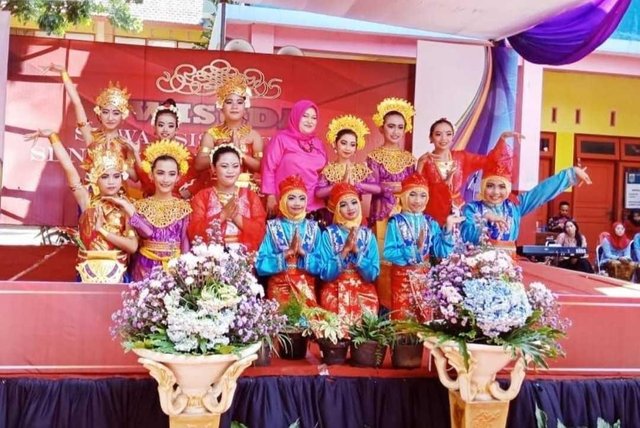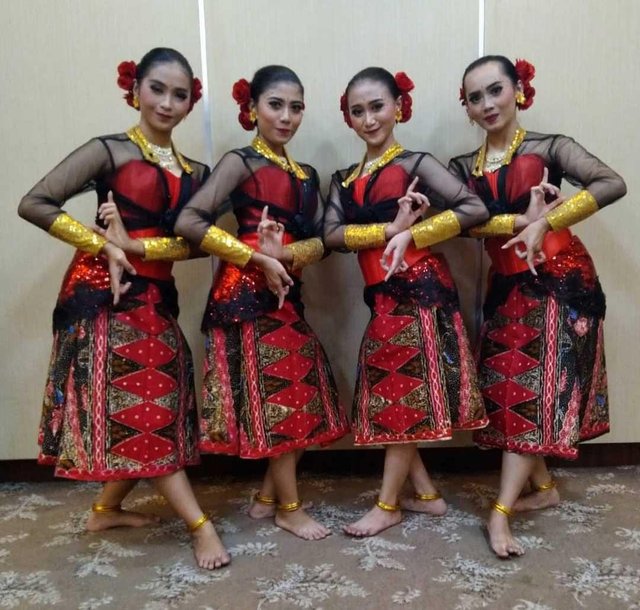madura dance
hello, fellow steemit Muang Sangkal dance is one of the traditional dances of the Madurese community which is carried out for the ritual of refusing reinforcements or keeping away from danger. This dance is often displayed in various events such as welcoming large guests and various other traditional events. Muang Sangkal dance is a very famous traditional dance and is one of the traditional art icons from Madura, East Java.

Historical Story of Muang Sangkal Dance
Muang Sangkal dance was created by an artist from Sumenep, Madura, East Java, named taufikurrachman. This dance was created as a sense of concern of the artists towards the wealth possessed by Madura which is full of works and uniqueness in it. Besides that, it also revives the history of the life of the Sumenep Palace in ancient times.
The name Muang Sangkal Dance itself is taken from the words "Muang" and "Sangkal". The word "muang" means to throw away, while the word "deny" itself means darkness or something related to devil or jin meal (in the teachings of ancient religion). However, the word denial for the Sumenep community can be interpreted as refusal or karma, for example, if parents have a daughter and are proposed by a man, they should not be rejected because they make the girl become invalid or not sell forever. So this dance can be interpreted as wreaking havoc.
Function and Muang Sangkal Dance
For Madurese, Muang Sangkal Dance is considered to be able to keep away from danger or waste bad luck. According to its function, this dance is often displayed in various events such as traditional events, weddings and also the reception of great guests who come there.
Muang Sangkal dance and performance
In the performance of the Muang Sangkal Dance performed by female dancers. The number of dancers displayed must be odd, can be one, three, five and so on. In addition, because it is a dance that is fairly sacred, the dancer displayed must be in a sacred condition or coming in a month.
In the show, beginning with a quick movement, the dancer walked hand in hand towards the stage. After that it was followed by a more subtle movement, the dancer danced while carrying a cemong or brass bowl containing various kinds of flowers and sprinkling them with soft and beautiful movements. The movement is certainly aligned with musical accompaniment.
Music and Accompanying Muang Sangkal Dance
In the Muang Sangkal Dance performance, it is accompanied by the Keraton's typical Gamelan Music. Gendhing is used to accompany Muang Sangkal Dance such as sampend gendhing, oramba '- orambe ’gendhing and other gendhing.
Muang Sangkal Dance Costume

The clothing used in the Muang Sangkal Dance is a typical Sumenep legha wedding dress, with a blend of distinctive colors namely red, yellow and black. At the top, the dancer uses a black tapestry and a chest cover cloth worn around the neck. While at the bottom uses a long cloth inside and outside using some additional red and yellow cloth as a sweetener. The head uses a crown with various floral ornaments. In addition, there are also a number of additional accessories such as a belt, a bracelet and a bow. For properties that are used when dancing such as sampur and cemong.
Development of Muang Sangkal Dance
In its development, the Muang Sangkal Dance is still being preserved and is still alive today. Apart from its function, the love of the community for the culture of ancestral heritage greatly influenced the existence of the Muang Sangkal Dance. In its development, this dance is still displayed in various events there such as traditional events and welcoming guests. Besides this dance is also often displayed at various cultural festivals, both in the area and outside the region. This is done as a preservation effort and introduces to the wider community the Muang Sangkal Dance.